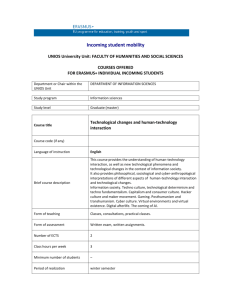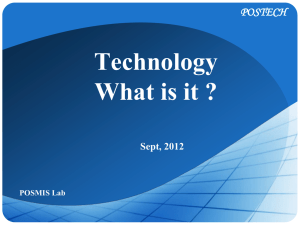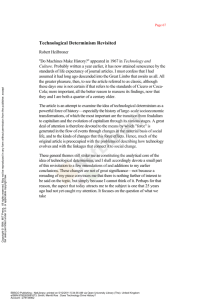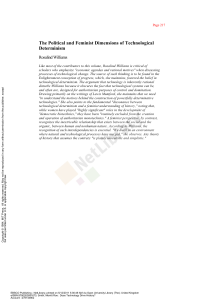Derya Kitapciyan
advertisement
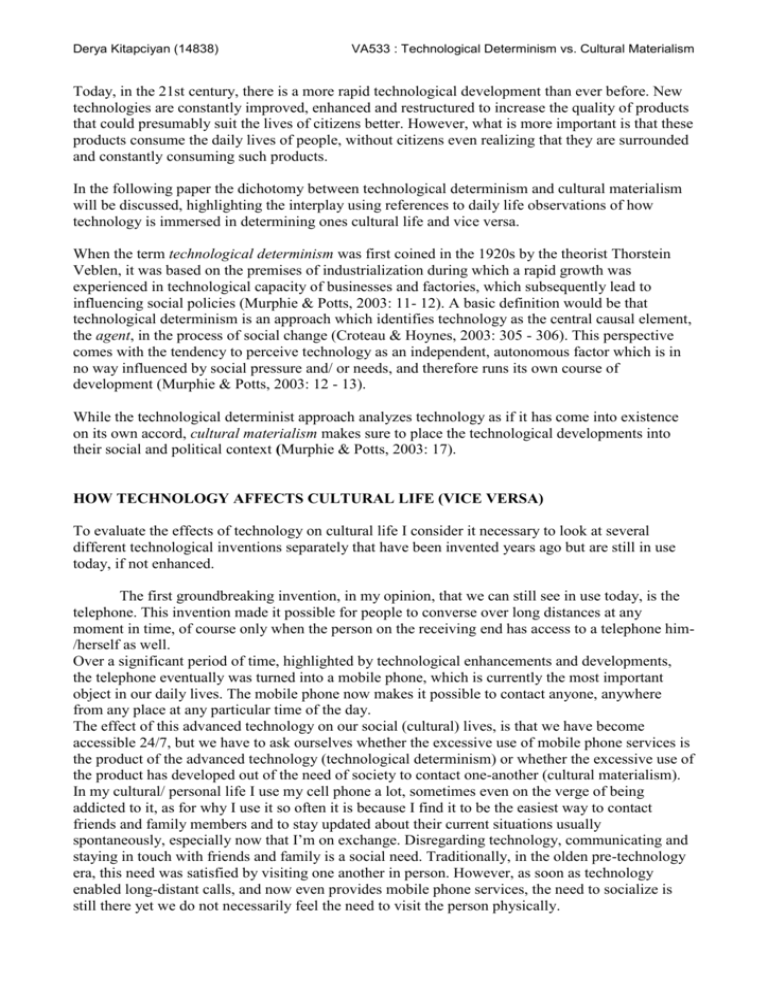
Derya Kitapciyan (14838) VA533 : Technological Determinism vs. Cultural Materialism Today, in the 21st century, there is a more rapid technological development than ever before. New technologies are constantly improved, enhanced and restructured to increase the quality of products that could presumably suit the lives of citizens better. However, what is more important is that these products consume the daily lives of people, without citizens even realizing that they are surrounded and constantly consuming such products. In the following paper the dichotomy between technological determinism and cultural materialism will be discussed, highlighting the interplay using references to daily life observations of how technology is immersed in determining ones cultural life and vice versa. When the term technological determinism was first coined in the 1920s by the theorist Thorstein Veblen, it was based on the premises of industrialization during which a rapid growth was experienced in technological capacity of businesses and factories, which subsequently lead to influencing social policies (Murphie & Potts, 2003: 11- 12). A basic definition would be that technological determinism is an approach which identifies technology as the central causal element, the agent, in the process of social change (Croteau & Hoynes, 2003: 305 - 306). This perspective comes with the tendency to perceive technology as an independent, autonomous factor which is in no way influenced by social pressure and/ or needs, and therefore runs its own course of development (Murphie & Potts, 2003: 12 - 13). While the technological determinist approach analyzes technology as if it has come into existence on its own accord, cultural materialism makes sure to place the technological developments into their social and political context (Murphie & Potts, 2003: 17). HOW TECHNOLOGY AFFECTS CULTURAL LIFE (VICE VERSA) To evaluate the effects of technology on cultural life I consider it necessary to look at several different technological inventions separately that have been invented years ago but are still in use today, if not enhanced. The first groundbreaking invention, in my opinion, that we can still see in use today, is the telephone. This invention made it possible for people to converse over long distances at any moment in time, of course only when the person on the receiving end has access to a telephone him/herself as well. Over a significant period of time, highlighted by technological enhancements and developments, the telephone eventually was turned into a mobile phone, which is currently the most important object in our daily lives. The mobile phone now makes it possible to contact anyone, anywhere from any place at any particular time of the day. The effect of this advanced technology on our social (cultural) lives, is that we have become accessible 24/7, but we have to ask ourselves whether the excessive use of mobile phone services is the product of the advanced technology (technological determinism) or whether the excessive use of the product has developed out of the need of society to contact one-another (cultural materialism). In my cultural/ personal life I use my cell phone a lot, sometimes even on the verge of being addicted to it, as for why I use it so often it is because I find it to be the easiest way to contact friends and family members and to stay updated about their current situations usually spontaneously, especially now that I’m on exchange. Disregarding technology, communicating and staying in touch with friends and family is a social need. Traditionally, in the olden pre-technology era, this need was satisfied by visiting one another in person. However, as soon as technology enabled long-distant calls, and now even provides mobile phone services, the need to socialize is still there yet we do not necessarily feel the need to visit the person physically. Derya Kitapciyan (14838) VA533 : Technological Determinism vs. Cultural Materialism In this particular case I would say that the social need and the technological enhancement are complementary to each other, rather than one forcing the other to come to exist. This meaning that we, as human beings, already had the need to socialize and that the technology was developed accordingly to satisfy this need, yet at the same time the established technology triggered an obsession within people to make use of the technology regardless of whether they need to or not. The second most important invention is the Internet. Nowadays, we can see how the Internet has come to replace age old traditions and acts, which can be looked on as both good and bad developments to come to affect our cultural life. This counts especially for the younger generation who, sometimes branded as digital natives, grew up in a time period that belongs to the digital era (information age). With the introduction of the Internet to the public, just like it was the case with the introduction of the telephone, we soon found ourselves able to access any kind of information on every imaginably possible topic from places we would normally have difficulty to access. The sudden information-overload was not the only product of the Internet, it also enabled instant messaging with distant friends and family member (and strangers) and more recently the Internet has become a carrier for more advanced products such as applications (for smartphones and tabs) and games. In this case, however, I do feel as if the Internet technology has brought around social change. I grew up in the ‘90s and for a large part of my childhood, the only kind of information, music, movies or shows I could access were the products I could access by going to the library, reading actual books or buy cassette tapes to listen to music. Nowadays, I see that my 11 year-old sister does not enjoy the same digi-free childhood I experienced, instead she grows up in an environment which is increasingly digitalized and globalized. The Internet has managed to cramp every product into bits and bytes, so that books, music and movies can all be enjoyed from the (dis-) comfort of your screen, yet there was no real social need for this product to come and dominate our cultural lives. Instead, what happened was that with the increasingly accessible Internet, official institutions such as schools, started to set higher expectations for the works students hand in. Students are expected to browse long enough and good enough to find reliable sources. This doesn’t just count for me as an university student, this is also expected by my sister’s elementary school teachers. Currently, I would say that the technologies discussed above are the two main technologies at the moment that would characterize the "global village" which McLuhan predicted. The most important characteristic of these technologies however is that they enabled a time-space compression in which transferring and obtaining information is no longer bound to geographical locations, distances or time (Thussu, 2006: 59). Based on my personal observation on the Internet, it could be easy to say that technological developments are the agents of social change, but I wouldn’t agree with the statement myself simply because new developments wouldn’t last long in an environment that is not ready for such changes, or does not feel the need for such technologies. An example for this are probably the recent developments in Africa, where instead of an increase in landlines (telephones) there has been an increase in mobile phone usage. Concluding, I would say that rather than technology influencing cultural life, or cultural/ social needs influencing technological development, these two realms are really more intertwining. Derya Kitapciyan (14838) VA533 : Technological Determinism vs. Cultural Materialism Bibliography Croteau, D., & Hoynes, W. (2003). Media society: industries, images, and audiences (3rd ed.). Thousand Oaks, California: Pine Forge Press. Murphie, A., & Potts, J. (2003). Culture and technology. New York: Palgrave Macmillan. Thussu, D. K. (2006). International communication: continuity and change (2nd ed.). Rydalmere: Hodder Education.




